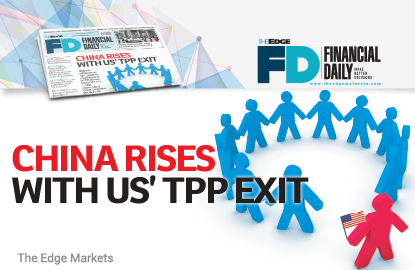
KUALA LUMPUR: As an uncertain future dawns on the Trans-Pacific Partnership (TPP) agreement with the official withdrawal of the US, China is seen as playing a bigger role in the changing trade landscape in the Asian region.
On Monday, US President Donald Trump started his first day in office by signing an executive order to withdraw from the TPP, reaffirming his administration’s protectionist agenda.
IHS Global Insight chief economist Rajiv Biswas said in a note yesterday that China “is likely to play a stronger lead role in future Asia-Pacific trade architecture” a notion signalled by Chinese President Xi Jinping.
During the World Economic Forum in Davos last week, Xi said that his country will position itself as a champion of trade liberalisation.
China has already initiated, and is participating in several trade-friendly initiatives, such as the Regional Comprehensive Economic Partnership (RCEP), Free Trade Area of the Asia Pacific (FTAAP) and the One Belt, One Road initiative.
“Some TPP member countries may prefer to refocus on the RCEP as an alternative large-scale regional trade liberalisation initiative. The US’ withdrawal from [the] TPP will galvanise momentum for the successful conclusion of the RCEP,” Rajiv said.
RCEP members include Australia, New Zealand, Japan, South Korea, China and Asean.
Minus the US, the TPP would have 11 member countries — Australia, Brunei, Canada, Chile, Japan, Malaysia, Mexico, New Zealand, Peru, Singapore and Vietnam.
While the transition was anticipated by industries in Malaysia, those that were optimistic to expand international market share through the TPP are now having a less positive outlook and are in search of other options to achieve their targets.
International Trade and Industry Minister Datuk Seri Mustapa Mohamed said in a statement yesterday that the failure for the TPP to materialise “will be a missed opportunity for Malaysia”.
“As I have said in Davos during the World Economic Forum, should the TPP fail to materialise, our focus would be to enhance the economic integration of Asean in the context of the Asean Economic Community (AEC) Blueprint 2025, push for the timely conclusion of the RCEP, as well as pursue bilateral FTAs (free trade agreements) including with TPP members whom we currently do not have any preferential trading arrangement,” he added.
Palm oil products were among the casualties of a stalled TPP. In 2014, exports of palm oil products to TPP countries were well over RM13 billion, and the agreement would have raised the figure to RM20 billion by 2021.
The TPP would have opened the door to North America for the Malaysian manufacturing export sectors as well, through improved market access and reduced tariff barriers.
“Of course, it is not good news for Malaysia, though it is not something unexpected. The reason Malaysia joined the TPP is to export more and gain larger market share in the participating countries,” Socio-Economic Research Centre (SERC) executive director Lee Heng Guie told The Edge Financial Daily.
Without the TPP, Lee said it it is business as usual for Malaysia — there will not be growth in “leaps and bounds” in terms of market share or trades for Malaysia as expected with the TPP.
However, it is not the end of the world, Lee said. “Malaysia can continue to have bilateral trade agreements with individual countries. [It is] just that it will take a longer time,” he added.
For Malaysia, bilateral FTAs with other TPP countries is one option to “mitigate the loss”, Plantation Industries and Commodities Minister Datuk Seri Mah Siew Keong said.
“Other TPP countries can go ahead with the pact and salvage the hard work of so many years,” Mah told reporters at the 19th Malaysia Strategic Outlook Conference 2017, Bernama reported.
Former secretary-general of the ministry of international trade and industry Tan Sri Rebecca Sta Maria noted that the TPP has value, and the efforts put into the plan should not be negated.
According to another Bernama report, Sta Maria said that the US is just one out of 12 participating nations, and that the remaining members should meet and discuss the action plan.
Institute of Strategic and International Studies economist Firdaos Rosli told The Edge Financial Daily that the Malaysian government can still utilise what was learned throughout the TPP negotiation process.
“Through the process, Malaysia would have learned how the world’s biggest economy operates.
“Internationally, it is best for Malaysia to wait and see how the other 10 countries react. Domestically, we can already begin cherry-picking and implement the better rules and regulations within our shores,” Firdaos said.
“Malaysia needs to look at possible quick gains that can be achieved from this development. In the meantime, we have many other trade options,” he added.
However, Firdaos noted that the RCEP cannot be equated to the TPP.
“[The] RCEP is more of a consolidation of existing trade initiatives in the Asian region, While [the] TPP is a clean slate meant to provide equal protection between host countries and investors.
“They are different things with different objectives, and one cannot simply replace the other,” he said.
SERC’s Lee reiterated, noting that the TPP has a higher standard of clauses and regulations, covering labour, environment and intellectual property issues.
The bigger concern, Lee said, is the potential trade war between the US and China, the world’s largest- and second-largest economies, which is expected to have a domino effect and further dampen the already sluggish global trade.
“It is still unknown whether Trump would pursue anti-trade measures, which can be punitive tariffs to make China’s goods less competitive, to fulfil his pledge,” Lee warned, noting that the global trades have fallen since the 2008 financial crisis.